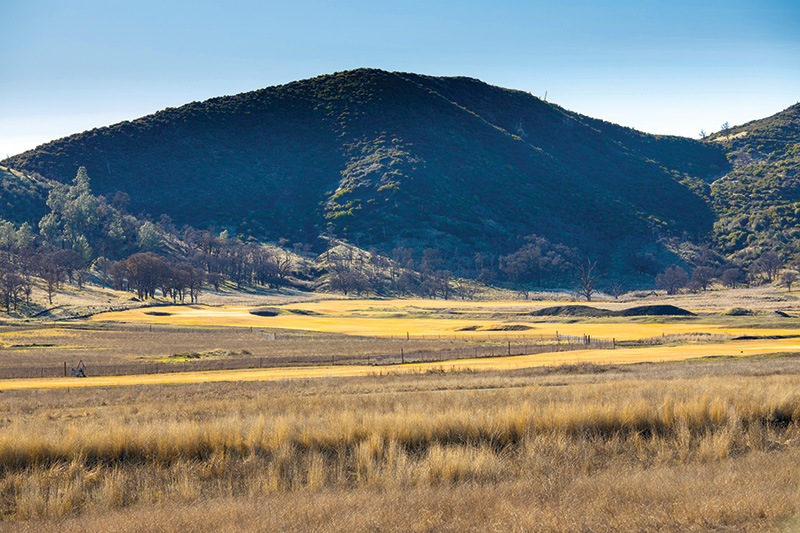
Brambles is a new golf course set on 600 acres in Middletown, Calif. Photos by Lawrence Lauterborn
The crazy, contradictory, confounding thing about Brambles is that the new course in the California wine country is so far behind the times, in its own way it just might be way ahead of them.
Brambles, set on 600 nearly treeless acres in Middletown, about an hour north of Napa, in many ways is as forward-looking as they come, with a contemporary eye toward miserly use of water and other inputs, next-generation turfgrasses and a less-is-more approach to maintenance.
“We want it to play,” says GCSAA Class A superintendent Tyler Marcotte, “better than it looks.”
And yet, for all that future proofing baked into it, well …
“The vision, as it was laid out to me, it’s basically golf if you time travel back 100 years,” says Marcotte, a seven-year GCSAA member who has spent the past nearly three years at the course with no set par, which officially opened in April 2024. “It’s golf without all the unnecessary stuff that has crept into American golf — the overwatering, the overfertilizing, some of the things from an aesthetics side that don’t seem necessary at a place like this.
“It’s just a golf course. There’s no tennis courts. It’s not a suit-and-tie clubhouse. It’s just a place to play golf and enjoy it. It’s less uptight, I guess. It’s a place to play golf. That’s what we’re here for.”
Oh, did we forget to mention the sheep? Remember that whole throwback aesthetic Marcotte was mentioning? Part of the Brambles backbone is a flock of sheep who are more than a four-legged gimmick. In fact, they’re part of the staff.
“We want them incorporated in native control, 100%,” Marcotte says of his cloven-hooved crew. “How we can make that feasible is the trick now. There are plenty of things we haven’t tried yet, but we’ll figure it out.”
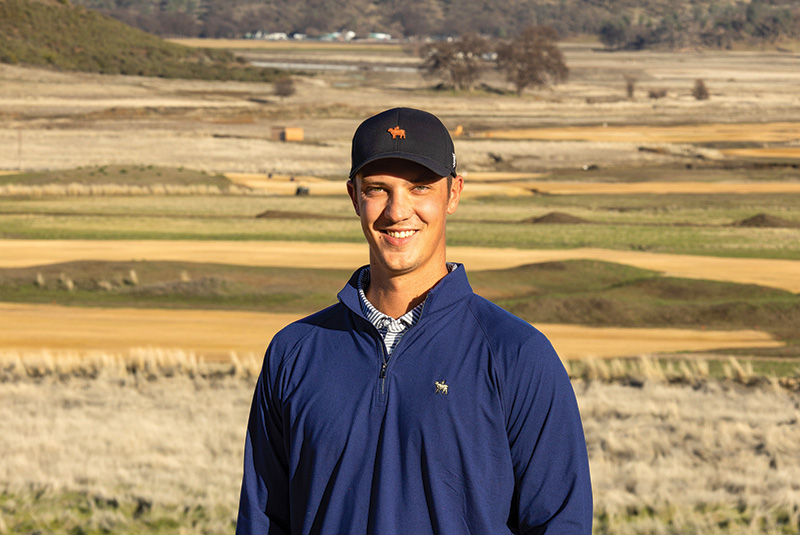
Tyler Marcotte says there’s been a bit of a learning curve with Brambles’ zoysiagrasses.
‘Born 100 years too late’
Brambles is the vision of golf course architect James Duncan.
Duncan, principal of J.H. Duncan Golf Course Architects, grew up in Denmark and Scotland before he landed in the States. He worked with the likes of Gil Hanse and Tom Doak before teaming up with Ben Crenshaw and Bill Coore, hitting both coasts — from Hidden Creek Golf Club in Egg Harbor Township, N.J., to Bandon Dunes Golf Resort in Bandon, Ore. — plus projects overseas in China and Japan.
Brambles is his baby. He rounded up investors, found the property, spearheaded its purchase and permitting and envisioned a golf course the likes of which Old Tom Morris himself would find familiar.
“They say James was born 100 years too late,” says Marcotte, whose first superintendent job came at another Coore & Crenshaw course, Clear Creek Tahoe in Carson, Nev., where a mutual acquaintance connected the two for the Brambles opening.
Work began in 2020, and Brambles was expected to open the following year. The pandemic blew that timeline, and Marcotte — who since had left Clear Creek Tahoe, where he served under a director of grounds, to head his own department, at 26, at Sandia Golf Club in Albuquerque — was contacted by Duncan.
“I thought it was unique for sure,” says Marcotte, a Pennsylvania native who got his start in the industry by toiling in the pro shop during his high school days before, in need of more hours, eventually migrating to the maintenance crew. “I thought it was really cool. I’d never really been a part of any major construction or grow-ins, so that was good to see.”
Marcotte says the course had been shaped and “a couple” of holes planted before time ran out on the growing season for the summer of 2021, and he reported to Brambles in February 2022.
“That was our big planting year,” Marcotte says. “Mostly everything was planted in 2022, that summer.”
Brambles is, unusually for this part of northern California, all warm-season zoysiagrass, with Zeon zoysia fairways and tees and Prizm zoysiagrass greens.
“This,” Marcotte says, “was the first time I’d ever seen zoysia.”
It was not love at first sight.
“I remember in August of that year staring at the first fairway we had planted and thinking, ‘What’s going on?’ There was nothing there,” says Marcotte, who admits to a steep learning curve. “It takes a while. But we trusted our fertilizer plan, our watering plans. Then you come in one day and it looks like it’s starting to make it. Patience is the key. You have to be patient. It’s not for everybody to try to grow from sprigs, especially in a different climate that’s not used to it. It’s not fast. You don’t get instant results.”
Marcotte said he was told to expect a two-year span from initial grassing — the whole course was established with sprigs, with sod touch-ups — to fully established. “And that was pretty much right on,” he says.
He and the crew have learned that zoysiagrass has a short growing season in NoCal, waking up in May and going fully dormant around mid-November.
The thicker-leafed Zeon is mowed to a height of around 0.350-0.400 inches (0.889-1.016 centimeters), while Marcotte says the staff is “still finding its way” maintaining the Prizm greens.
“It’s newer and less common on greens throughout the U.S.,” he says. “It’s not easy to find superintendents that have it to bounce ideas off of. I was talking to one superintendent in Tennessee who has it, but they sodded theirs. There just aren’t a lot of people well-versed in it. We rarely see ball marks, which is great. We’re just working on getting them to speed, fine-tuning all the cultural practices.”
Marcotte is convinced the juice is worth the squeeze.
“They’re really great grasses,” he says. “They don’t require much water at all once they’re established. The water savings once we get into tracking that … I think a lot of people will be surprised how much we’re saving.”
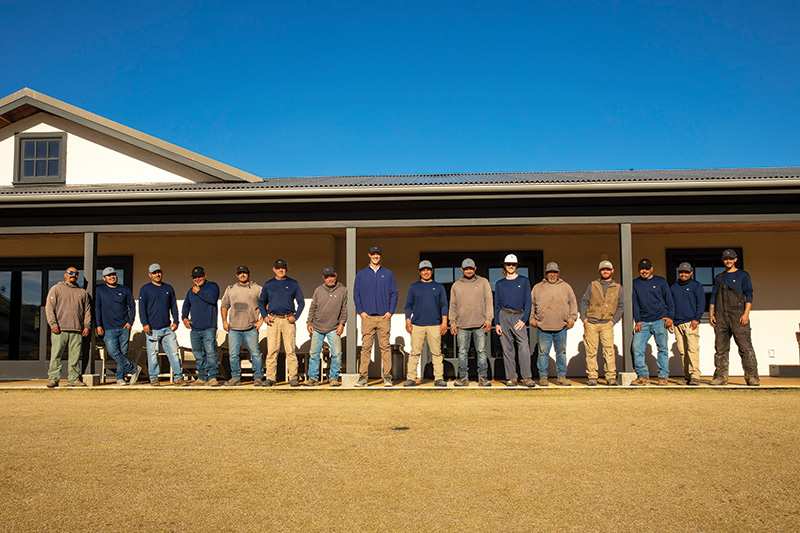
Marcotte (center) with the crew at Brambles, which is in Middletown, Calif., about an hour north of Napa.
Have you herd?
Now, about those sheep.
Of course, golf courses and sheep go way back. Legend has it the bunkers at St. Andrews were formed when the resident ungulates who helped maintain the famed Old Course huddled in depressions to shelter from the brutal Atlantic winds.
A few courses, especially across the pond, still employ sheep to maintain roughs, but the practice is all but unique in the U.S.
“When I signed on to the job, the idea we were going to maintain all the natives, and the valley in general, with sheep, I thought that was cool,” says Ryan Player, Brambles’ ranch manager.
“I grew up around farming. It was a natural thing for me. When the opportunity came, I thought, ‘Somebody has to take this over, or it’s going to fail.’ I didn’t want to see it fail. It’s one of the things that sets Brambles away from the crowd.”
As ranch manager (and chief shepherd), Player is in charge of construction, development projects, building maintenance — and the Brambles livestock program.
For now, that program consists of a flock of 45 sheep, which Player would like to double or triple in the near future.
“Forty-five is not enough to keep up with it,” Player says. “We’re looking to get closer to 100, 150 sheep to help maintain the course. We need to see where that sweet spot is. How many do we need?”
A Maine native who grew up on a potato farm, Player set out to “see the world.” He landed at Lake Tahoe, studied golf course maintenance and became irrigation tech, then assistant superintendent, in Incline Village, Nev., at The Golf Courses at Incline Village’s Championship Course. After about a year there, Player received a call from Marcotte, whom he’d known from Clear Creek, and wondered if Player wanted to visit Brambles for Marcotte’s assistant superintendent opening.
“I fell in love with the area and the project,” Player says.
Player served as Marcotte’s assistant superintendent about a year before it became apparent they needed to pivot. “Me and Tyler were managing everything,” Player says. “It was, ‘You take golf. I’ll take the rest of it.’”
Though he was familiar with the horticulture side of farming, Player admits to learning the livestock side “on the fly.”
“I’ve been around it,” he says. “I knew friends who had livestock. But learning day to day, I’m figuring it out. We live in a very agricultural area. There’s a lot of ranching around here — mostly cattle, but a couple of sheep operations. There’s a good local crowd that’s willing to help us out. They want us to succeed. I’d say the most surprising thing, honestly, is just how intense raising livestock can be, how much it takes. It’s seven days a week. You can’t just let them go in the field and not worry about them. They demand attention.”
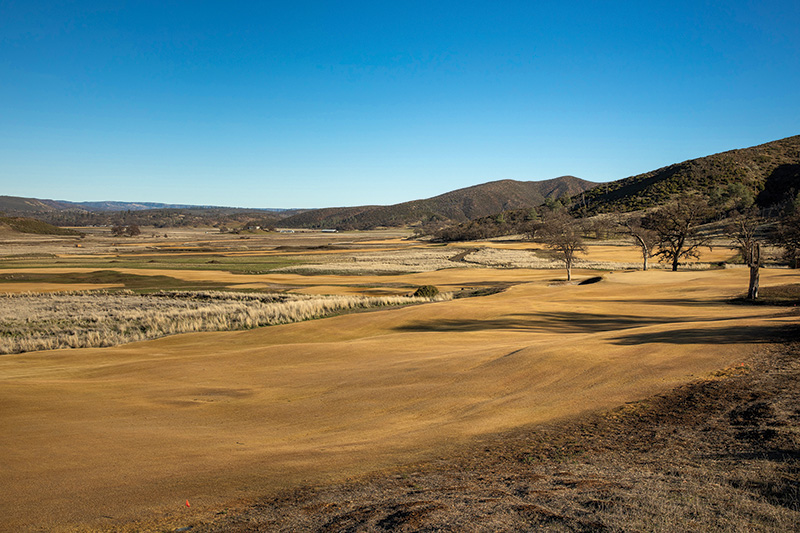
The course’s zoysiagrasses go dormant around mid-November and “start to come alive” again in May.
What the flock?
And what about said sheep’s herd work? It’s a bit of a mixed baaaaag.
“What the sheep do here is pretty amazing,” Player says. “You take a field of grass 2 feet tall, put them out there for a month … it’s amazing what they can do.”
What they leave behind is equally amazing — in more senses than one. For one thing, sheep don’t perform like a finely tuned mechanical mower. They’ll gnaw some plants down to the soil while leaving others in tufts.
“We don’t want standard 2-inch, 3-inch mowed rough that’s striped and full,” Marcotte says. “We think it should be natural. It’s hard to explain, but they leave it splotchy — natural.”
“You couldn’t recreate it with a weedwacker if you tried,” adds Player. “That’s part of what I fell in love with out here. That’s not something you see in America.”
The sheep leave behind a little something else, too.
“They do pee and poop,” Player says. “They will walk across the greens. We found that out when we experimented with it, and it ends up more of a hassle with cleanup, so we’re trying to move away from that and keep them more contained. At the end of the day, it’s a golf course, and you don’t want them on tees and greens. From that standpoint, I think my golf background helps. I just understand how turf works, how a golf course works, how golfers play and how a golf course functions. That definitely plays a role in how we move and use the sheep. Even from a fertilizer standpoint, Tyler might be, like, ‘Hey, I’d like the sheep to graze this a little harder. It’s looking glum. Let’s get some fertilizer on it.’”
Both men admit the sheep-as-crew project is very much a work in progress. The flock initially was contained in large electrified “pens,” but the crew is experimenting with geofencing — think “invisible fences” available for pets — to take a more organic-seeming approach. Ultimately, the plan is to have the sheep help in all rough areas, plus some fairways, as well as the surrounding valley and barrancas, providing fire-preventative maintenance as well as aesthetic (and labor-saving) contributions.
“There will be a learning curve with that (geofencing),” Player says. “Each sheep would have a collar, like a shock collar, then you’d have an app on your phone where you could trace corrals, areas you want them to be in. If they start to move outside, the collar starts beeping, then vibrating, then it starts shocking them until they decide to come back. It will take them some time to get used to that, but that’s the goal of where we want to be going. We want them to get out there where they’re more or less free roaming. We don’t want them fenced up like pets. We want to get them out there actually working so we can minimize maintenance. If you’re not maintaining roughs, you can save a lot of the maintenance end.”
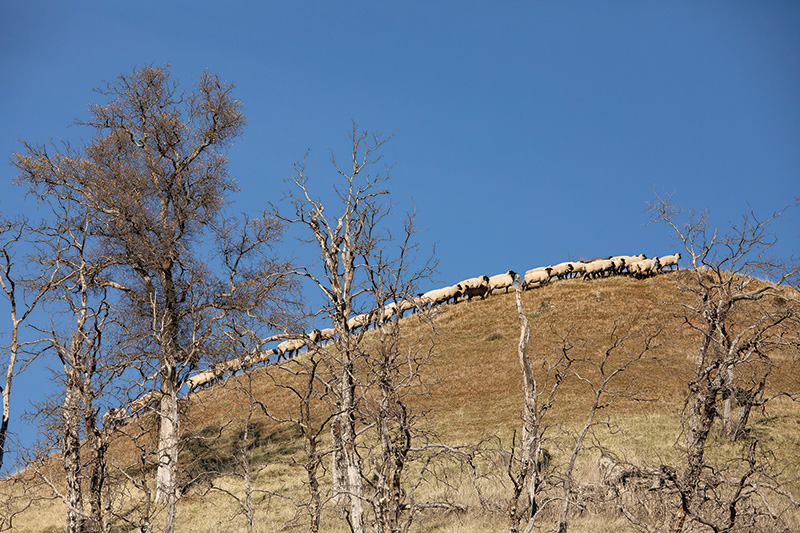
A flock of 45 sheep helps tend to Brambles’ rough areas, though the plan is to increase that to 100-150 sheep.
Past as future
What’s not to like about the Brambles model?
Especially in a state like California — where labor, water and, for that matter, potentially all inputs — are potentially fraught topics, the concept of a golf course that uses less of all of the above would seem a home run.
“It’s an exciting project to be a part of,” Player says. “I’d love for this to be a model for future golf courses … low maintenance, low inputs … it’s the future. The grass choices, the sheep — it doesn’t have to be sheep. Just the idea of going low inputs is the future.”
Marcotte, though, is torn.
“If we can stay unique, I’d love for people to follow our model,” he says. “But not everyone wants to do the same thing. I think it’s a good eye-opener, especially in California. The whole goal is to use less inputs — less fertilizer, less water — and maybe pull back on some of the unnecessary stuff. If that trickles into some other properties, I think that would be good for everybody. Our focus is more on playability than aesthetics. That’s something I’d like to see more in golf. You don’t have to have perfect stripes from the clubhouse deck. But it’s not going to change overnight.”
Sometimes, it doesn’t even change over a hundred or so years.
Andrew Hartsock (ahartsock@gcsaa.org) is GCM’s editor-in-chief.